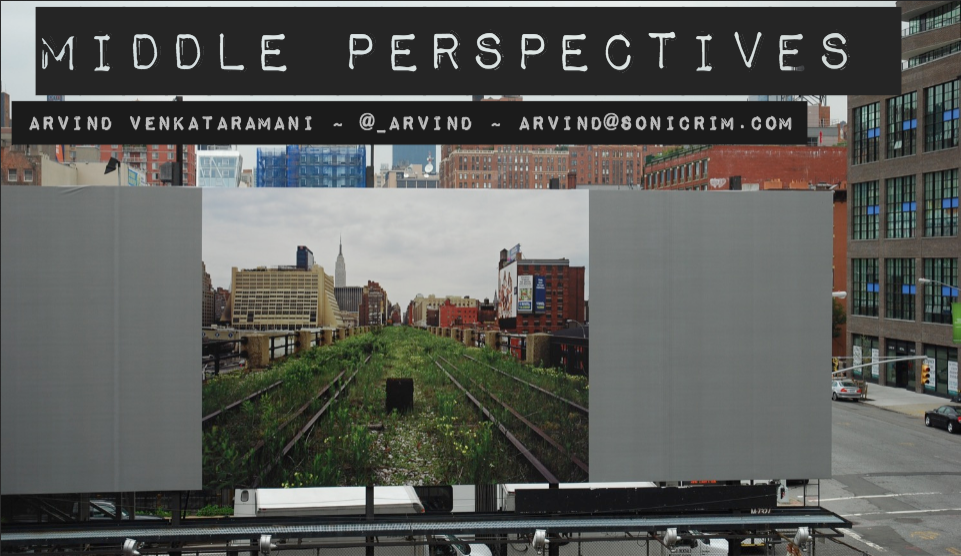by [contrib_author post_id=’6169′ name=’Arvind Venkataramani’], EPIC2016 PechaKucha Panel Lead
- Even in a heterodox community such as EPIC, ‘Papers’ can feel like a forbidding mechanism for generating knowledge and exchanging ideas. To those not accustomed to, or comfortable with, thinking verbally (and verbosely) EPIC Papers are an odd ‘Other’, and almost never experienced directly.
- Sometimes you just need to say things simply, quickly. This is why I love PechaKucha at EPIC. We’re all interesting people, but we don’t all speak the same way. Some of us do smarts without the words.
- PechaKuchas aren’t Papers-lite; they’re light dancing with ideas. Less a dressy formal waltz, more a bhangra – improvised, welcoming, perhaps even a little unrefined. But, hey, bhangra is fun, right?
- I want to show you how PechaKuchas work here in EPIC. And how they are actually much easier to put together than you might think. I hope that encourages you to dig a bit into your own experiences, and find things to share.
- If you haven’t cottoned on already, this is a PechaKucha masquerading as a blog post. It took me roughly about as long to put together (a couple of hours thinking, and perhaps an hour writing). Let me start with how you can use PKs at EPIC:
- First – Unpack a moment. We all have rich experiences, and some of them touch who we are as people. When we get to share in that moment – and what better than images to bring us there? – we are, for a bit, transformed. Yes, that right there, you think, happens to me too!
- Second – Point out the hidden. We might be observers by profession, but we can’t see and know everything. The world is a deeply strange place and sometimes we notice the oddest things. Sometimes those odd things have profound meaning, if we look closely.
- Third – Reflect. Hello, darkness, my old friend… I’ve come to face my work self again. Who are we? Are we getting this right? Am I alone in this? Sometimes the search for meaning is best shared.
- Fourth – Beta-test your insight. Have a new method? Seeing your work in a different light? Figured something out? Step up here and share; you’ll get people talking, and you are likely to get feedback that helps improve your idea.
- Fifth – Provoke. Make the familiar strange. Step outside our profession and point out something you see. Does the emperor not have clothes? Is there a storm coming? Speak up, speak up! Show us how it’s done elsewhere.
- So there you have it: five ways in which you can draw on your experiences to create a talk at EPIC. But is it really that easy to put a PechaKucha presentation together? I think yes, and I’ve personally found the attempt to do so has made me a better presenter. Some things I’ve realized along the way…
- It’s not a research report! (No, really. You don’t need structured slides. Text is optional. You don’t have to use fieldwork photos – or even any photos at all. Just doodle).
- The pace helps. (Knowing I only have 20 seconds with a slide helps me write quickly, and be more clear about what I have to say. I worry less, and produce more. And if you’ve never done this before, it’s actually quite surprising how long 20 seconds actually is).
- You don’t actually have to be all that coherent. (Perhaps you have this one single point to make. Excellent. But perhaps what you have is a profusion of loosely connected ideas that have something in common. That’s okay too. A PechaKucha is your opportunity to play).
- It’s theater…almost literally. (Since you can put whatever you like on the slides, you don’t have to speak to what’s on the screen. Want to create dissonance between speech and visuals? Want to use the screen as a set? Feel free).
- You can get lyrical, and emotional. (In fact, it’s often better this way; some stories are too personal to be intellectualized, to be subjected to the cold analytical lens of papers. You can be raw and vulnerable, and the audience will be the better for it).
- Silence can be powerful too. (17 seconds of silence…).
- JFDI – Just Freakin’ Do It! (Putting a PechaKucha together can be a way of getting unstuck, of developing that one notion that’s been nagging you for months. And once you present and share it, you’ll be one step further to really nailing it).
- …You might even realize you know things you didn’t know you knew. When I started writing this, all I had to go on was that I could write something about PKs being fun and easy. I had no idea I had so many things to say, much less that I could turn it into a PechaKucha draft.
- …If you’re hesitating to submit a PechaKucha to EPIC2016, I hope this changes your mind. You probably have things to say that we’d all like to hear, and you’re probably underestimating yourself. And if you enjoy EPIC PKs (and can relate to what I’ve written) let me know if I missed something!

In June of last year, I found myself in New York city, and decided to take a walk down an urban renewal experiment called the High Line. I’d gone expecting to experience something vaguely cool and hip, but the view turned to be much more interesting. Watch Arvind’s PechaKucha presentation from EPIC2012
We use the tools of our trade – curiosity and empathy, questioning and watching and listening – to cultivate the conditions of discovery that serve our objectives. But what gets discovered and by whom is not bound by our intent, and what results can be surprising. Paul Ratliff, “Collateral Revelation”, PechaKucha presentation at EPIC2014
 Arvind Venkataramani is Director of Research at SonicRim. He’s a hybrid design professional empowering entrepreneurs & innovators through ethnographic and design research, storytelling, and systems thinking.
Arvind Venkataramani is Director of Research at SonicRim. He’s a hybrid design professional empowering entrepreneurs & innovators through ethnographic and design research, storytelling, and systems thinking.

0 Comments